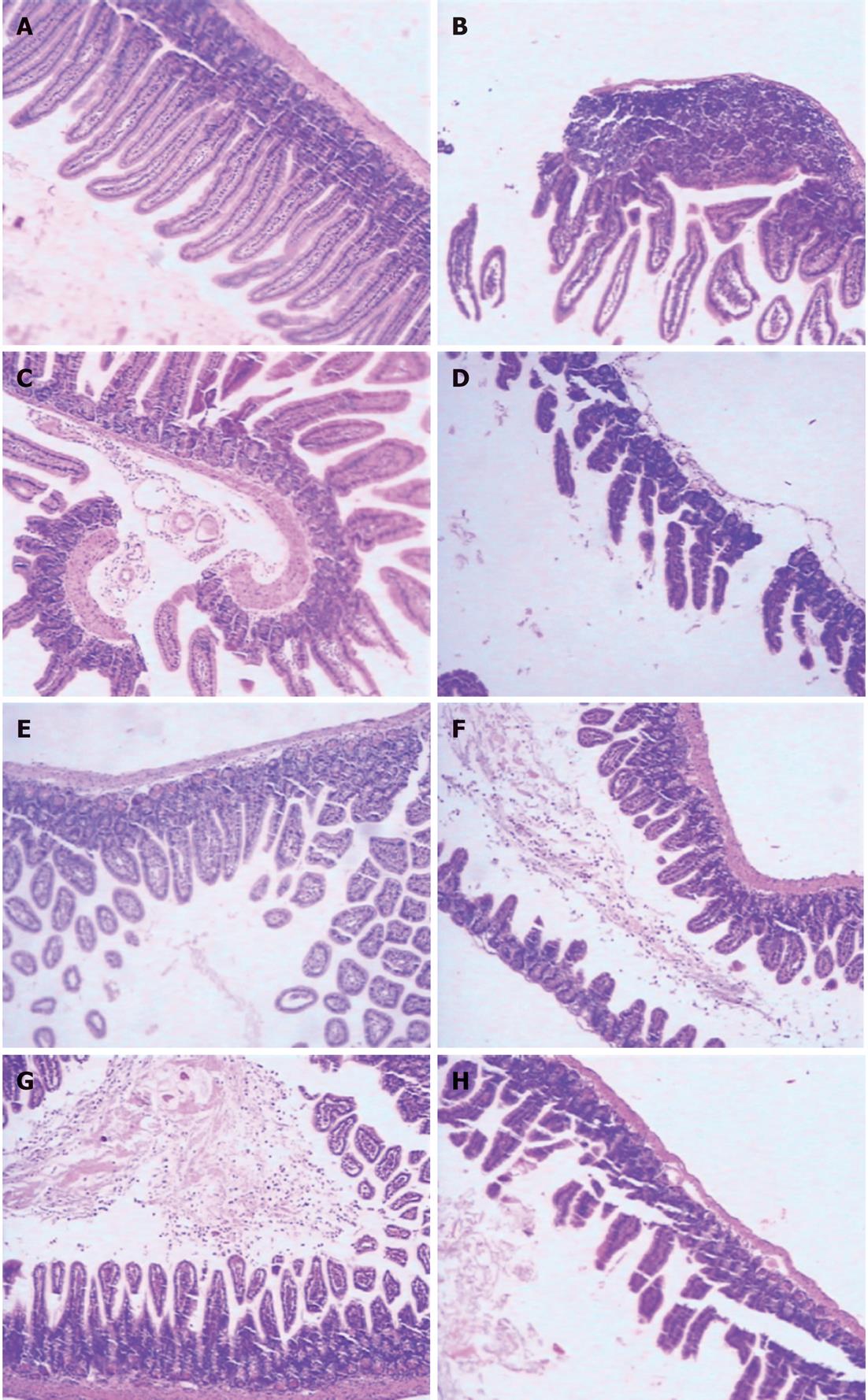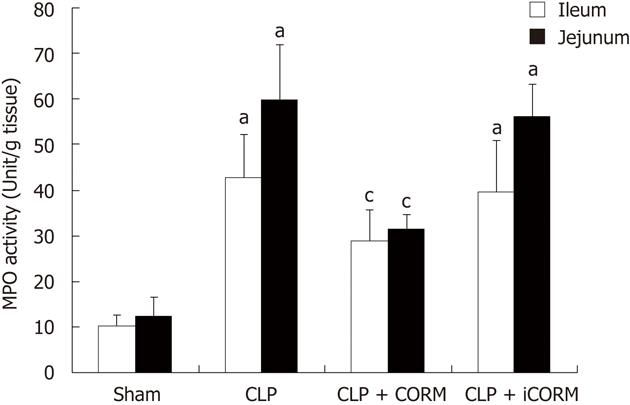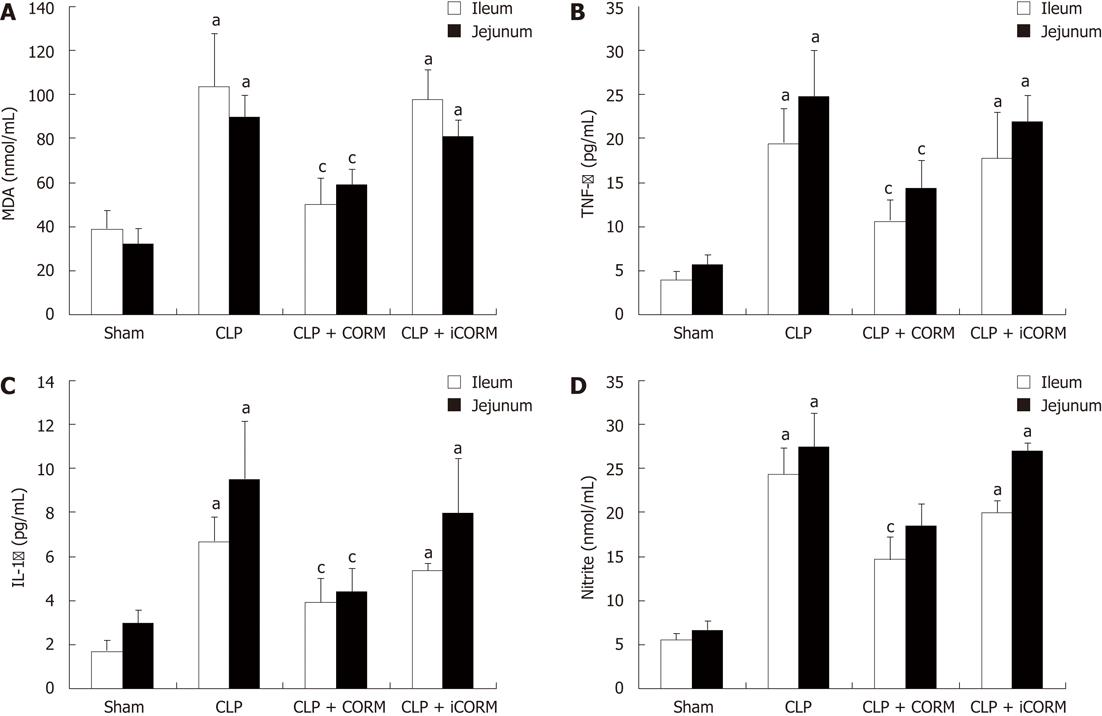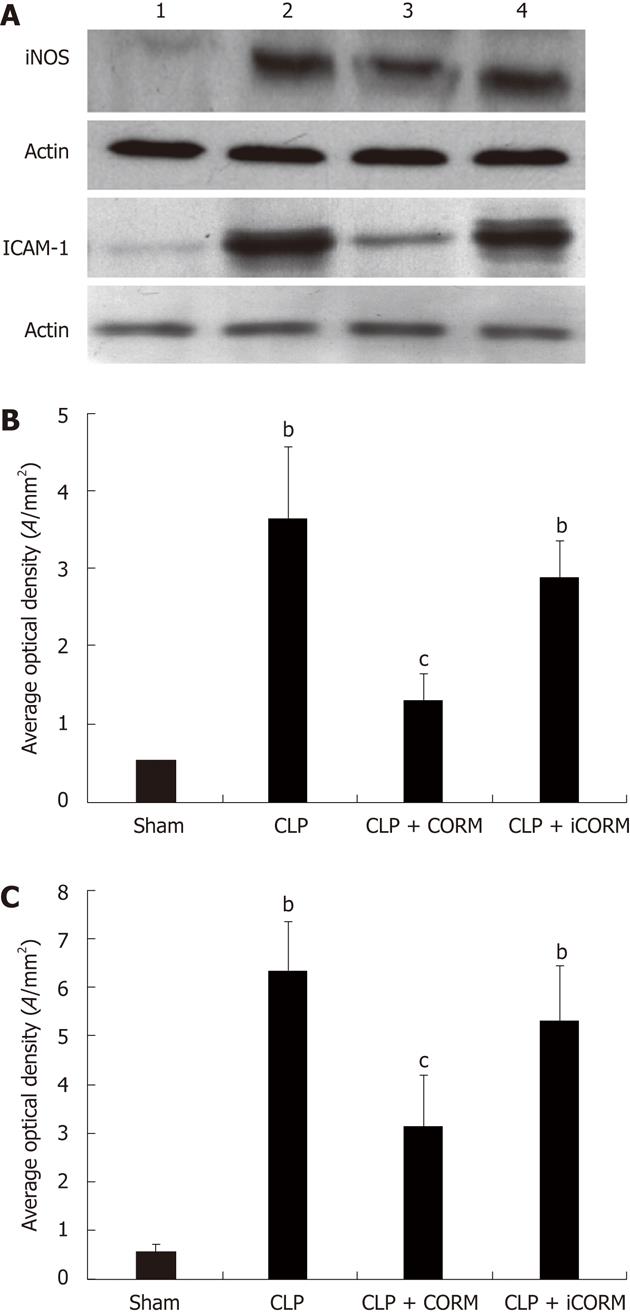Copyright
©2012 Baishideng Publishing Group Co.
World J Gastroenterol. Oct 28, 2012; 18(40): 5719-5728
Published online Oct 28, 2012. doi: 10.3748/wjg.v18.i40.5719
Published online Oct 28, 2012. doi: 10.3748/wjg.v18.i40.5719
Figure 1 Effects of tricarbonyldichlororuthenium (II) dimer carbon monoxide-releasing molecules on small intestine injury in septic mice.
Mice were challenged with cecal ligation and perforation (CLP) and treated with tricarbonyldichlororuthenium (II) dimer. The mid-ileum (A-D) and mid-jejunum (E-H) specimens harvested from different groups of animals were immersed in 4% formaldehyde solution at 24 h after CLP. The tissue was embedded in paraffin wax, serially sectioned, and stained with hematoxylin-eosin. Tissue morphologic characteristics were evaluated by light microscopy. A, E: Sections from sham mice had normal architecture of the intestinal epithelium and wall; B, F: Sections from septic mice showed inflammatory cell infiltration through the wall, concentrated below the epithelial layer, edema of the distal portion of the villi, and necrosis of the epithelium at the villous tips; C, G: Section from septic mice treated with carbon monoxide-releasing molecules-2 showed a significant decrease in granulocyte infiltration, while no marked improvement of hydropic degeneration. The figure is representative of at least three experiments performed on different days.
Figure 2 Effects of tricarbonyldichlororuthenium (II) dimer carbon monoxide-releasing molecules on myeloperoxidase activity in the small intestine of septic mice.
Mice were challenged with cecal ligation and perforation (CLP) and treated with tricarbonyldichlororuthenium (II) dimer. Myeloperoxidase (MPO) activity in the mid-ileum and mid-jejunum were assessed 24 h following CLP injury. Results are mean ± SE, aP < 0.01 vs sham mice; cP < 0.05 vs CLP mice. CORM: Carbon monoxide-releasing molecule; iCORM: Inactivated-carbon monoxide-releasing molecule.
Figure 3 Effects of tricarbonyldichlororuthenium (II) dimer carbon monoxide-releasing molecules on malondialdehyde, expression of interleukin-1β and tumor necrosis factor-α and nitrite production in the mid-ileum and mid-jejunum of septic mice.
A: Mice were challenged with cecal ligation and perforation (CLP) and treated with tricarbonyldichlororuthenium (II) dimer. Malondialdehyde (MDA) in the mid-ileum and mid-jejunum was assessed 24 h following CLP injury; B: Tumor necrosis factor (TNF)-α levels in the mid-ileum and mid-jejunum was assessed 24 h following CLP injury; C: Interleukin (IL)-1β levels in the mid-ileum and mid-jejunum was assessed 24 h following CLP injury; D: Nitrite production in the mid-ileum and mid-jejunum was assessed 24 h following CLP injury. Results are mean ± SE, aP < 0.01 vs sham mice; cP < 0.05 vs CLP mice. CORM: Carbon monoxide-releasing molecule; iCORM: Inactivated-carbon monoxide-releasing molecule.
Figure 4 Effects of tricarbonyldichlororuthenium (II) dimer carbon monoxide-releasing molecules on interleukin-8 and nitrite production in Caco-2 cells.
Caco-2 cells were stimulated by lipopolysaccharide (LPS) and treated with tricarbonyldichlororuthenium (II) dimer. Nitrite (A) and interleukin (IL)-8 (B) production in supernatants of Caco-2 cells were assessed 4 h following LPS stimulation. Results are mean ± SE. bP < 0.01 vs control group; cP < 0.05 vs LPS-stimulated Caco-2. CORM: Carbon monoxide-releasing molecule; iCORM: Inactivated-carbon monoxide-releasing molecule.
Figure 5 Effects of tricarbonyldichlororuthenium (II) dimer carbon monoxide-releasing molecules on protein expression of intercellular adhesion molecule 1 and inducible nitric oxide synthase in the mid-ileum of cecal ligation and perforation-induced mice.
A: Representative experiment; B and C: Quantitative results (average optical density, A/mm2) of three. Mice were challenged with cecal ligation and perforation (CLP) and treated with tricarbonyldichlororuthe-nium (II) dimer. Protein expression of intercellular adhesion molecule 1 (ICAM-1) and inducible nitric oxide synthase (iNOS) in the mid-ileum was determined by Western blotting at 24 h after CLP. Lane 1: Sham group; Lane 2: CLP group; Lane 3: CLP + carbon monoxide-releasing molecule (CORM)-2 group; Lane 4: CLP + inactivated-carbon monoxide-releasing molecule (iCORM)-2 group. bP < 0.01 vs sham group; cP < 0.05 vs CLP group.
- Citation: Wang X, Cao J, Sun BW, Liu DD, Liang F, Gao L. Exogenous carbon monoxide attenuates inflammatory responses in the small intestine of septic mice. World J Gastroenterol 2012; 18(40): 5719-5728
- URL: https://www.wjgnet.com/1007-9327/full/v18/i40/5719.htm
- DOI: https://dx.doi.org/10.3748/wjg.v18.i40.5719

















